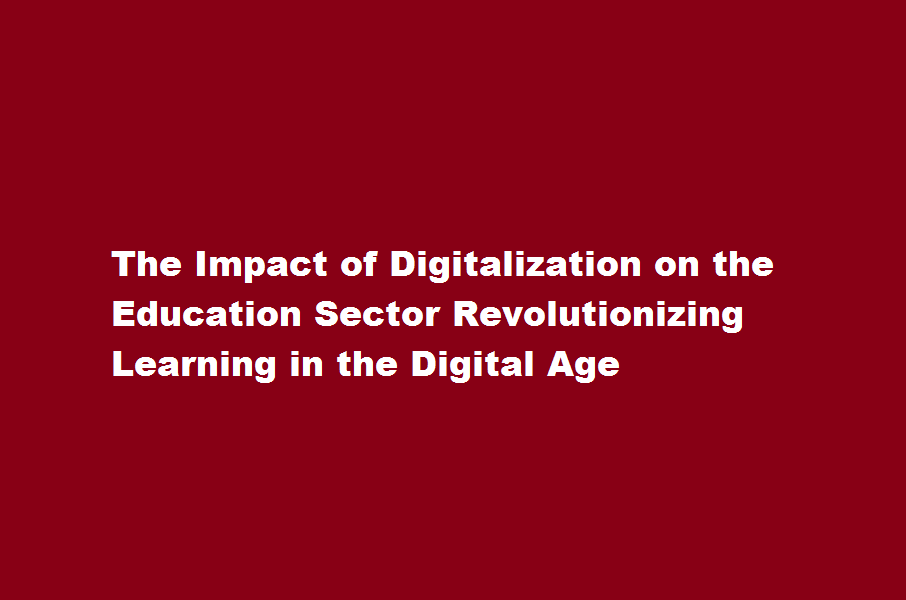The Impact of Digitalization on the Education Sector Revolutionizing Learning in the Digital Age
4 min read
Introduction
In recent years, digitalization has brought about a significant revolution in various aspects of our lives, and the education sector is no exception. The integration of digital technology in classrooms has transformed traditional teaching methods, creating a more dynamic and interactive learning environment. This article explores the profound influence of digitalization on the education sector, highlighting the benefits it brings to students, educators, and the overall learning experience.
Enhanced Access to Information
Digitalization has democratized access to information, breaking down geographical barriers and providing students with limitless resources. With a few clicks, learners can access vast repositories of knowledge, online libraries, and educational platforms, expanding their horizons beyond what traditional textbooks offer. Students can now conduct research, explore diverse perspectives, and gain a deeper understanding of subjects, all from the comfort of their homes or classrooms.
Personalized Learning
Digital tools have revolutionized the concept of personalized learning, catering to individual student needs and learning styles. Adaptive learning platforms employ algorithms to analyze student performance and deliver tailored content and assessments. This approach ensures that students receive targeted instruction, addressing their strengths and weaknesses. Digital platforms also offer interactive tutorials, simulations, and gamified learning experiences, fostering engagement and making education more enjoyable.
Collaboration and Communication
Digitalization has transformed the way students collaborate and communicate with their peers and teachers. Online discussion boards, virtual classrooms, and video conferencing tools enable seamless communication, irrespective of physical location. Students can engage in group projects, share ideas, and seek feedback from classmates and teachers, promoting collaborative learning and enhancing social interaction. This digital connectivity prepares students for the collaborative nature of the modern workforce.
Multimodal Learning
Gone are the days when textbooks were the sole medium of instruction. Digitalization has introduced multimodal learning, incorporating diverse media formats such as videos, interactive modules, podcasts, and virtual reality experiences. This multimodal approach caters to different learning preferences and enhances comprehension and retention. Students can visualize complex concepts, engage with interactive content, and develop a deeper appreciation for the subject matter.
Global Learning Opportunities
Digitalization has opened up a world of global learning opportunities for students. Online courses, webinars, and virtual exchange programs connect students from different cultures and backgrounds. They can engage in cross-cultural discussions, share perspectives, and broaden their worldview. Digital platforms also facilitate access to renowned educators and experts worldwide, enabling students to learn from the best in their respective fields.
Streamlined Administrative Processes
Digitalization has streamlined administrative processes within educational institutions, making tasks more efficient and reducing paperwork. Digital tools automate attendance tracking, grading, and course management, freeing up valuable time for educators to focus on instruction and student support. Additionally, online learning management systems enable easy access to course materials, assignments, and grades, enhancing transparency and organization.
Frequently Asked Questions
How has digitalization transformed classroom instruction?
Digitalization has transformed classroom instruction by introducing interactive content, personalized learning, and collaborative tools that enhance student engagement and facilitate effective teaching.
What are the benefits of digitalization in education?
Digitalization in education provides enhanced access to information, personalized learning experiences, improved collaboration and communication, multimodal learning opportunities, global connections, and streamlined administrative processes.
Does digitalization replace traditional teaching methods entirely?
Digitalization does not replace traditional teaching methods entirely but complements them by integrating technology to enhance instruction and provide a more comprehensive learning experience.
How does digitalization promote student engagement?
Digitalization promotes student engagement through interactive content, gamified learning experiences, virtual collaboration tools, and personalized learning approaches tailored to students’ needs and interests.
What challenges come with digitalization in education?
Some challenges of digitalization in education include the need for technological infrastructure, ensuring digital equity, addressing privacy and security concerns, and providing adequate training and support for educators in utilizing digital tools effectively.
How can educators embrace digitalization in their teaching practices?
Educators can embrace digitalization by incorporating digital tools, multimedia resources, and online platforms into their teaching practices, attending professional development programs, and collaborating with peers to share best practices.
Conclusion
Digitalization has had a transformative impact on the education sector, revolutionizing traditional teaching methods and creating a more dynamic and inclusive learning environment. With enhanced access to information, personalized learning experiences, improved collaboration, and global connections, students are better equipped for success in the digital age. As technology continues to advance, educators must embrace digitalization to harness its full potential and empower future generations of learners.
Read Also : The Impact of Digitalization on The Job Market Exploring Employment Opportunities






